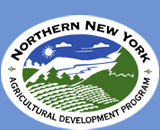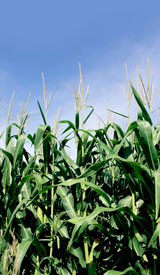


May 21, 2007
Contacts: Dr. Donald R. Viands, Cornell University, 607-255-3081
Dr. Elson J. Shields, Cornell University, 607-255-8428
Note: ASB fact sheets are found online at
www.nnyagdev.org
Cornell Researchers and Farmer Report More Progress Against Pest
Peculiar to Northern New York
Alfalfa snout beetle is an invasive insect pest peculiar to Northern New
York and parts of Canada across the St. Lawrence River. The alfalfa
snout beetle (ASB) eats the roots of alfalfa, destroying a vital forage
crop for dairy cattle and other livestock. Field surveys funded by the
Northern New York Agricultural Development Program in 2005 and 2006 show
the areas infested with ASB continues to expand in Franklin, Jefferson,
Lewis and St. Lawrence counties. Cornell University researchers funded
by the Northern New York Agricultural Development Program are advancing
two promising control methods for the destructive agricultural pest.
Dr. Donald R. Viands, a plant breeder at Cornell University, is
developing ASB-resistant alfalfa varieties. He says, �We have seen the
first true evidence that breeding can increase the ASB resistance levels
in alfalfa. Our ultimate goal is to develop ASB-resistant alfalfa
varieties that are persistent and productive.�
Developing resistance in plants, however, takes time and patience. In
1998, Viands evaluated 173 alfalfa plant populations collected near
Watertown, NY. Some plants showed ASB resistance at a low level.
�First, we identified the plants with resistance genes, then we selected
the best of those plants and began the long-term breeding process to
build up the resistance in the alfalfa varieties with the greatest
potential for success,� Viands says.
Alfalfa varieties grown in Hungary where the alfalfa snout beetle is
native were obtained as an ASB-resistant gene selection source for the
project.
�Over time and several cycles of selection the frequency of the
resistance genes in the plants increases. Since 2003, Jamie Neally, a
member of our ASB research team, has completed three to four cycles in
15 different plant populations showing lower level root damage in
greenhouse trials,� Viands says.
Because insect pressure in farm fields is not uniform, field screening
of plants bred for resistance to ASB exposure can be unreliable as an
evaluation method. So, with a Northern New York Agricultural Development
Program grant, Viands, Dr. Elson J. Shields of Cornell University�s
Department of Entomology and Research Support Specialist Anthony Testa
developed a reliable greenhouse screening protocol. The method allows
the researchers to control the insect pressure on the plants by
controlling the number of insect eggs applied to each plant and the
length of time the insect larvae are allowed to feed on the alfalfa
roots.
One plant population in the greenhouse showed the level of damage
decreasing from a score of 3.86 (a score of 1 indicates no root damage,
5 equals a totally destroyed root or a dead plant) to 2.90 after three
cycles of selection.
Field evaluation of the most-resistant alfalfa varieties will begin on
Northern New York farms in 2008.
Jefferson County Farm Harvesting Results of Patience with Research
Project
The plant populations showing promise include varieties chosen from the
most elite in the Cornell Forage Breeding Program, varieties from
Hungary, and plants identified on the John Peck farm in Jefferson
County, NY. Since 2003, a total of 83,000 plants have been evaluated.
Viands says the development of ASB resistance varieties used in
combination with other control measures will provide increased
protection from the pest to the alfalfa crop in Northern New York.
Shields has identified and been testing biological control organisms,
namely entomopathogenic (insect-killing) nematodes, that are showing
promise in field trials at the Peck farm near Great Bend.
Shields introduced nematodes native to New York on the Peck family farm
in various field plots between 1991 and 1999. The farm had seen
populations of one to 2.5 million beetles per acre and the Pecks had
lost entire crops of alfalfa with a resulting decrease in milk
production and increased production costs caused by the need to purchase
protein supplement and seed to replant alfalfa fields.
The fall 2005 survey for ASB showed an absence of larval feeding damage
to alfalfa roots on the farm and more alfalfa than the Peck family had
seen since ASB invaded the farm in 1985.
John D. Peck says, �A few years ago I saw this strange looking root
sticking out of our plowed alfalfa fields. I asked my dad what it was
and he told me they were alfalfa tap roots. This year will be my
twentieth year working on the farm and until about four years ago I had
never seen an alfalfa tap root because of the snout beetles.
�These bugs are a major nuisance and have cost us a lot of money over
the years,� Peck says. �Our cows milked well on grass fields and grass
hay, but now they have transitioned to the richer alfalfa forage once
again since the decline in the snout beetle population. We are very
thankful and encouraged by the Northern New York Agricultural
Development Program-funded research that Cornell University has
conducted here.�
He believes the nematodes will be the best method for controlling ASB in
areas already infected with the insect and that the ASB-resistant
alfalfa hybrid breeding will be more beneficial to areas that are at
risk for infestation, but have not had a major outbreak such as in
Northern New York.
Shields says, �The frequency of nematodes in the soil samples from the
Peck farm in 2006 is similar to the frequency seen in soil samples from
the parts of Hungary where the alfalfa snout beetle is not easily found
and is not considered a crop pest.�
Now that the nematodes have shown their potential to reduce ASB
populations in infested areas, Shields is working to develop an
effective and easily implemented method for farmers to inoculate their
alfalfa fields with the biological control organism. Shields believes
that field trials in 2006 were sabotaged by mice, shrews and skunks
which ate the inoculation medium that contained the nematodes. An array
of other inoculation techniques are being field tested in 2007.
Farmers often do not realize they have the pest, because crop loss to
ASB mimics winterkill with the majority of the alfalfa crop dying after
the last harvest and before spring growth. Shields says although the ASB
population has decreased on the Peck farm, neighboring farmers should be
vigilant. Millions of the insect have been seen and collected within a
mile of the Peck farm. ASB is also expanding its range in Ontario,
Canada, with new discoveries as far north as Ottawa.
Farmers who suspect they have ASB should contact their local Cornell
Cooperative Extension office.
For more information on the alfalfa snout beetle projects funded by the
Northern New York Agricultural Development Program, a farmer-led
research, education and outreach program, go online to
www.nnyagdev.org. # # #
